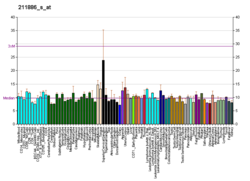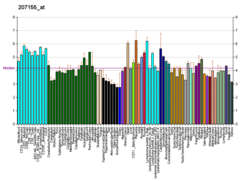T-box transcription factor TBX5, (T-box protein 5) is a protein that in humans is encoded by the TBX5 gene.[5][6][7] Abnormalities in the TBX5 gene can result in altered limb development, Holt-Oram syndrome, Tetra-amelia syndrome, and cardiac and skeletal problems.
This gene is a member of a phylogenetically conserved family of genes that share a common DNA-binding domain, the T-box. T-box genes encode transcription factors involved in the regulation of developmental processes. This gene is closely linked[clarification needed] to related family member T-box 3 (ulnar mammary syndrome) on human chromosome 12.
TBX5 is located on the long arm of chromosome 12.[8] TBX5 produces a protein called T-box protein 5 that acts as a transcription factor.[9] TBX5 is involved with forelimb and heart development.[10] This gene impacts the early development of the forelimb by triggering fibroblast growth factor, FGF10.[11]
- ^ a b c GRCh38: Ensembl release 89: ENSG00000089225 – Ensembl, May 2017
- ^ a b c GRCm38: Ensembl release 89: ENSMUSG00000018263 – Ensembl, May 2017
- ^ "Human PubMed Reference:". National Center for Biotechnology Information, U.S. National Library of Medicine.
- ^ "Mouse PubMed Reference:". National Center for Biotechnology Information, U.S. National Library of Medicine.
- ^ Basson CT, Bachinsky DR, Lin RC, Levi T, Elkins JA, Soults J, et al. (January 1997). "Mutations in human TBX5 [corrected] cause limb and cardiac malformation in Holt-Oram syndrome". Nature Genetics. 15 (1): 30–35. doi:10.1038/ng0197-30. PMID 8988165. S2CID 30763654.
- ^ Terrett JA, Newbury-Ecob R, Cross GS, Fenton I, Raeburn JA, Young ID, Brook JD (April 1994). "Holt-Oram syndrome is a genetically heterogeneous disease with one locus mapping to human chromosome 12q". Nature Genetics. 6 (4): 401–404. doi:10.1038/ng0494-401. PMID 8054982. S2CID 30213.
- ^ "Entrez Gene: TBX5 T-box 5".
- ^ Patel C, Silcock L, McMullan D, Brueton L, Cox H (August 2012). "TBX5 intragenic duplication: a family with an atypical Holt-Oram syndrome phenotype". European Journal of Human Genetics. 20 (8): 863–869. doi:10.1038/ejhg.2012.16. PMC 3400730. PMID 22333898.
- ^ Jhang WK, Lee BH, Kim GH, Lee JO, Yoo HW (August 2015). "Clinical and molecular characterisation of Holt-Oram syndrome focusing on cardiac manifestations". Cardiology in the Young. 25 (6): 1093–1098. doi:10.1017/s1047951114001656. PMID 25216260. S2CID 43846874.
- ^ Cite error: The named reference
Steimle_2017was invoked but never defined (see the help page). - ^ Nishimoto S, Wilde SM, Wood S, Logan MP (August 2015). "RA Acts in a Coherent Feed-Forward Mechanism with Tbx5 to Control Limb Bud Induction and Initiation". Cell Reports. 12 (5): 879–891. doi:10.1016/j.celrep.2015.06.068. PMC 4553633. PMID 26212321.






